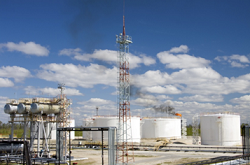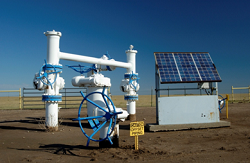Solenoid Valve Technology for Upstream Oil and Gas Heating Equipment
Low-temperature stainless-steel fuel shutoff valves are typically used for on/off control of fuel gas within gas fuel trains in process heating system burners.
#solenoids #automation
In recent years, a new generation of solenoid valve technology has been changing the shutoff valve game. Their modern designs provide pipeline and tank heating systems with robust, durable performance; safety; and regulatory compliance—all while increasing efficiency and productivity.
A safety shutoff valve plays a crucial role within a heating system. Simply put: If the valve doesn’t work, neither does the heater. And heater failure can quickly have a mission-critical impact: slowing or halting oil or gas flow in a pipeline, preventing offloading from tank to truck, or stopping separation of particulates from extracted heavy oil.
Newer solenoid shutoff valve technologies are making this operation safer, more efficient and environmentally friendly.
However, even when utilizing the latest solenoid technologies, designing valves for this unique application remains a challenge. Surveying the available offerings, it becomes clear that not all solenoid shutoff valves are created equal. Look for models that harness the best technology to maximize efficiency, safety, and service life in harsh or corrosive environments, and that incorporate the following advantages.
Low-Temperature Operation
Today, even some solenoid valves can experience challenges in delivering reliable operation in low-temperature environments. Look for valves that are rated for the range of operational temperatures likely to be encountered at your deployed location or locations.
Wide Pressure Range
When specifying gas shutoff valves, pay special attention to operating pressures. Some solenoid valves require a pressure “assist” to open and stay open. If the pressure supply to the valve falls below this minimum pressure differential (often on the order of 3 psi), the valve will close, thus shutting off heat to the pipe or tank. The problem is that some sites have inherently low supply pressure. In these locations, solenoid-based shutoff valves requiring a pressure assist may struggle, cause nuisance shutoffs or fail to operate at all.
By contrast, valves with lower maximum pressure ratings may be poor fits for sites with high supply pressures. Make sure your valve’s maximum operating pressure rating suits the operating pressures to be encountered at the intended location of the heating system.
Low-Power Consumption
At remote installations, power is often in short supply, so that valves may draw electrical power from generators, solar arrays or battery packs. Also, valves that don’t use wellhead gas for pneumatic power require added equipment such as compressors, filters, regulators and lubricators. So users prefer control equipment that minimizes power consumption as much as possible.
Most early solenoid valves used in these applications continuously drew over 20 W of power: a distinct drawback for many users. In succeeding years, valve designers re-engineered their products, striving to cut power consumption for remote applications. Almost all models are now much improved.
Reliable Performance
Before processing, most gas contains some impurities or entrained particulates. These can pose problems for reliable shutoff operation. For example, experience in Canada indicates that clogging due to these particulates was a source of user complaints about solenoid shutoff valves for pipeline and tank heating equipment.
Of course, few if any solenoid valves can handle really “dirty” gas. But some solenoid valve makers produce more forgiving designs.
Proof of Closure
Safety regulations in many jurisdictions require that valves use proof of closure (POC) when employed in burner systems within certain firing rates. With POC, an electrical contact is provided when the valve seal is in the fully closed position, enabling an electrical signal (contact closure) to be interlocked with the controller safety circuit. Confirming the valve’s closed position is an important consideration when starting and stopping larger pipeline and tank heating systems.
Until recently, POC was available solely in actuated valve packages. However, users have been trying to move away from these older technologies for reasons already mentioned. It is only recently that OEMs and users can find solenoid valves with POC built in.
Regulatory Compliance
In North America and around the world, governments have been tightening regulations, and increasingly demanding third-party validation of burner management equipment. Experts predict more regulations in more markets in coming years, plus greater enforcement of regulations already in place—all due to concerns about code compliance and the environment, plus worker and community safety.
This makes it imperative to consult with your manufacturer or supplier, making sure that critical components such as gas shutoff valves meet all appropriate certifications for your application and location.
Users can also help ensure compliance and reliable performance by making sure valves are properly tested. Query a prospective supplier about the development and testing regimen a given valve has undergone: Is it extensive? Does it test all production units, or only a few? Does it subject tested units to extreme conditions? Do tested conditions match those found on your sites?
Conclusion
Tightening regulations, continuing safety concerns and industry-wide efforts to achieve greater efficiency are all fueling a move toward solenoid shutoff valve technology in heating system applications. Fortunately, ongoing improvements mean this category now offers a number of excellent products that deliver innovative performance benefits.
Evaluate how well a prospective valve meets your site’s and application’s needs for low-temperature performance, wide pressure ranges, power consumption savings, proof of closure, regulatory approvals and more. With careful selection, you can choose a solenoid safety shutoff valve that provides your heating system with regulatory compliance, reliable performance and savings.
Bob Cadwell is business development manager of ASCO Numatics (Canada). He is responsible for identifying new product opportunities and introduction of new product solutions for the Canadian market. Reach him at bob.cadwell@emerson.com.
Gerry Longinetti is the industrial segment marketing manager of ASCO Numatics. He is responsible for creating and executing marketing product strategies and identifying new product solutions for the combustion, engines & transmission, pumps, compressors, blowers, dust collectors, sterilizers, packaging, agriculture and machinery equipment industries. Reach him at gerry.longinetti@emerson.com.
James Chiu is the industrial segment marketing product engineer of ASCO Numatics. He is responsible for identifying and introducing new product solutions for customers in the combustion, agricultural and gas generator equipment industries. Reach him at james.chiu@emerson.com.
The content of this article was originally produced as a whitepaper by Asco Valve, Inc. (www.ascovalve.com). It has been edited for use in VALVE Magazine. For more information contact info-valve@asco.com © 2014 ASCO Valve, Inc. All rights reserved
RELATED CONTENT
-
Water Hammer
Water hammer is a shock wave transmitted through fluid contained in a piping system.
-
Isolation Valves for High-solids Severe Service
Understanding suspended solids and their effect on equipment is critical in choosing isolation valves for slurry service.
-
Check Valves: The Most Important Valves in Your Process System
Check valves, as critical as they are for flow system performance, often don’t receive the respect they are due, said Arie Bregman, vice president and general manager, DFT, Inc., in a recent VMA presentation.













 Unloading large gate valve.jpg;maxWidth=214)